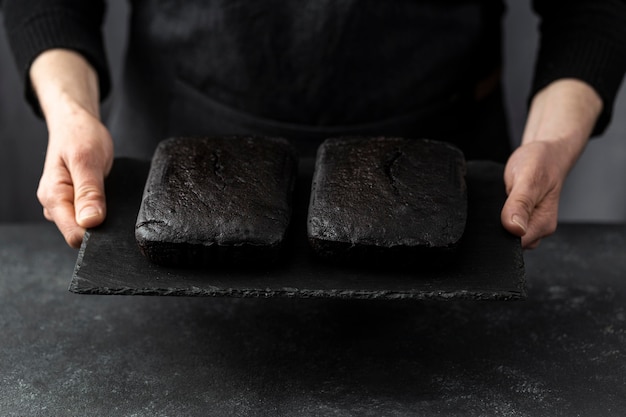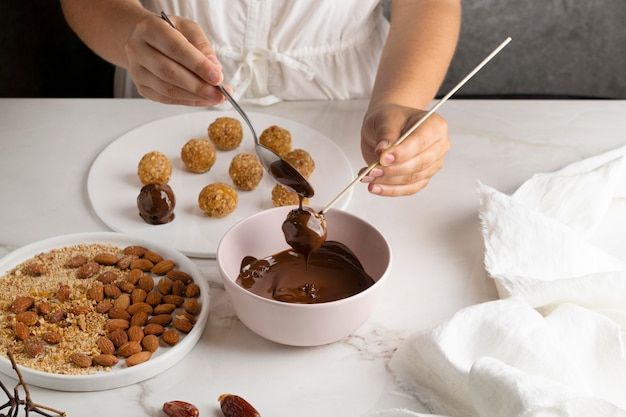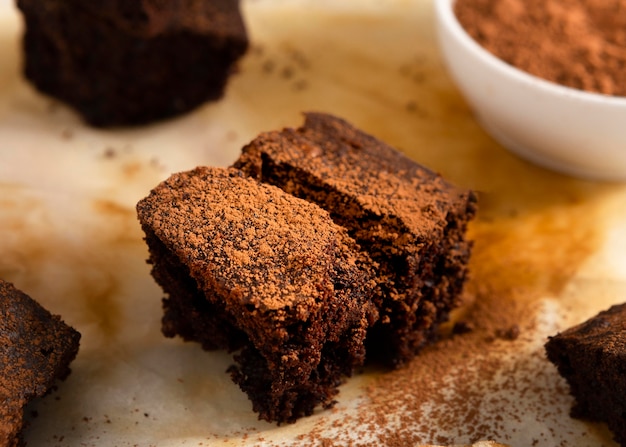The anticipation is building! You’ve gathered your ingredients, your recipe is ready, and your oven is preheating. But then it hits you – the baking time. How long do I bake them for? Will they be gooey and fudgy or dry and crumbly? And how do I avoid those dreaded undercooked edges?
Don't fret, fellow brownie enthusiast! Baking brownies is an art, and mastering the baking time is crucial. It's not just about blindly following a recipe – it's about understanding the magic happening inside your oven and knowing exactly what to look for. And that's where I come in.
In this guide, I’ll share my personal experiences, tips, and tricks for crafting those perfect brownies, the kind that melt in your mouth and leave you wanting more. We'll delve into everything from selecting the right pan to deciphering the telltale signs of perfectly baked brownies. So grab your apron, preheat your oven, and let’s embark on this delicious journey together!
(Part 1) Getting Started: The Basics

The Importance of Choosing the Right Pan
Let's start with the foundation. The pan you choose has a significant impact on how your brownies bake, especially when it comes to determining the perfect baking time.
Here's a breakdown of what to consider:
- Size Matters: A smaller pan, like a 9x13 inch, will cook faster than a larger one, like a 10x15 inch. You'll need to adjust the baking time accordingly.
- The Material Makes a Difference: Darker pans, like those made of aluminum, absorb more heat, which can lead to faster baking. You might need to reduce the baking time by a few minutes if using a darker pan.
- Shape and Even Baking: A square or rectangular pan is ideal for brownies because it ensures even heat distribution. Round pans can lead to uneven baking, making it harder to achieve that perfect texture.
The All-Important Preheat: Setting the Stage for Success
Never underestimate the power of preheating your oven. It's like setting the stage for a perfect bake! Preheat your oven to the temperature specified in your recipe and allow it to reach the desired temperature before you even think about placing your brownie pan inside.
Why is preheating so crucial? It ensures that your oven is hot enough to bake the brownies evenly. Without proper preheating, your brownies might take longer to cook, leading to uneven baking and potentially a soggy center. It's simply not worth the risk!
(Part 2) Understanding the Signs of a Perfectly Baked Brownie

So, you've got your ingredients prepped, your oven is preheated, and your chosen pan is ready to go. Now, you need to know what to look for to ensure your brownies are perfectly baked. This is where the art comes in!
The Toothpick Test: A Kitchen Essential
The trusty toothpick test is a baking classic for a reason! It's a simple but effective way to gauge whether your brownies are done. Simply insert a toothpick into the center of the brownie. If it comes out clean, your brownies are ready. But if it comes out with wet batter clinging to it, they need more time in the oven.
Here's a little secret I've learned over the years: Don't worry if a few crumbs cling to the toothpick. Those are perfectly normal. It's the wet batter that signals they need more baking time.
Don't Underestimate the Power of Sight
While the toothpick test is invaluable, your eyes are also powerful guides. As your brownies bake, you'll notice changes in their appearance. The edges will become slightly darker, and the surface will appear set and slightly firm. But remember, this doesn't mean they are fully cooked through.
If the edges seem excessively dark or the top appears overly dry, it could be a sign that your brownies are already overcooked. Be sure to check the center for doneness as well.
The Jiggle Test: The Ultimate Sign of Doneness
Now for the fun part, the jiggle test! This is my personal favorite method for assessing brownie doneness. It's all about movement. Gently jiggle the pan. A perfectly baked brownie will wobble slightly in the center but not be completely liquid. It should be set around the edges and have a slight "jiggle" in the middle.
If your brownie jiggles too much, it's not done yet. If it doesn't jiggle at all, it could be overcooked. Practice this test a few times to get a feel for the perfect jiggle – it's like a brownie dance!
(Part 3) Navigating the Baking Time: Tips and Tricks

You've got your recipe, but remember, baking times can vary based on your oven, the type of pan, and even the altitude you live at. It's always a good idea to check your brownies a few minutes before the recommended baking time.
The Art of Adjusting Baking Times
Remember, you can always bake for a little longer, but it's harder to undo overbaked brownies. So, err on the side of caution and start checking early. Use the toothpick and jiggle tests to guide you.
The Importance of Rotating the Pan
To ensure even baking, rotate the pan halfway through the baking time. This helps distribute the heat evenly and prevents uneven cooking. Just be careful when handling the hot pan – use oven mitts or a potholder!
Don't Open the Oven Door Too Often: Resist the Urge!
We all want to peek at our brownies during the baking process, but each time you open the oven door, you let out heat and can potentially disrupt the baking process. Try to resist the urge to open the oven door too often, especially during the first half of the baking time.
If you absolutely must check on your brownies, do it quickly and carefully. Keep the oven door open for as short a time as possible.
(Part 4) Understanding the Role of Temperature
You've chosen your pan, preheated your oven, and are paying attention to the jiggle test, but how does oven temperature impact your brownies? It's a crucial factor in determining their texture and how quickly they bake.
The Difference Between Oven Temperatures
A lower oven temperature will result in a slower bake, which can give you a more gooey, fudgy texture. Think of it as a gentle embrace for those chocolatey layers. A higher oven temperature will bake them faster, resulting in a more cakey consistency – a slightly crispier bite.
How to Adjust Temperature for Different Results
If you're aiming for a gooey brownie with a slightly soft center, bake at a lower temperature for a longer period of time. This allows the center to cook slowly, maintaining that delightful fudgy texture.
If you prefer a cakey brownie with a crisp top, bake at a higher temperature for a shorter period. This will create a quicker rise and a more substantial crust.
Don't be afraid to experiment! Adjust the oven temperature slightly based on your desired texture and check your brownies a few minutes before the recommended time to ensure perfect doneness.
(Part 5) Dealing with Overcooked Brownies: Don't Panic!
We all make mistakes, and sometimes, even with all the tips and tricks, our brownies end up overbaked. Don't panic! It's not the end of the world. Overcooked brownies might not be as gooey as you'd hoped, but you can still salvage them and make them delicious.
Don't Throw Them Away!
Overcooked brownies can be salvaged and enjoyed. Try chopping them up and using them in other desserts like ice cream toppings, brownie sundaes, or even in a brownie crumble topping for a fruit pie.
The Power of a Little Milk: Bringing Back Moisture
If your brownies are slightly dry, you can try adding a little milk to make them more moist. Sprinkle a tablespoon or two of milk over the brownies and cover them with a damp paper towel. Let them sit for a few minutes to allow the milk to absorb into the brownies. This can help soften the texture and add some moisture back in.
The Magic of the Microwave: A Quick Fix
If your brownies are really dry, you can try microwaving them for a few seconds to help soften them. Just be careful not to overheat them. Start with 10-15 seconds and check the brownies after each interval until they've reached your desired level of moistness.
(Part 6) Beyond Baking Time: Understanding Different Brownie Textures
The baking time isn't the only factor that determines your brownie's texture. The ingredients, their proportions, and even the type of chocolate you use all play a role. Let's explore some common brownie textures and how they're achieved.
The Fudgy Brownie: The Ultimate Gooey Indulgence
Fudgy brownies are known for their gooey, intensely chocolatey texture. They have a slightly soft center and a slightly chewy, almost fudgy bite. To achieve this, use a recipe that includes a higher proportion of butter and sugar. Think rich and decadent!
The Cakey Brownie: A Lighter, More Airy Treat
Caky brownies have a lighter, more airy texture that’s closer to a cake. They have a crisp outer layer and a slightly chewy inside. To achieve this, use a recipe with a higher proportion of flour and a little less butter. This will create a more structured brownie with a distinct crispness.
The Chewy Brownie: A Perfect Balance of Soft and Crunchy
Chewy brownies strike a balance between fudgy and cakey. They have a slightly soft center and a chewy, slightly crispy edge. To achieve this, use a recipe with a good balance of butter, sugar, and flour. This creates a brownie with a satisfying chewiness that's not overly soft or dense.
(Part 7) Mastering the Art of Brownie Baking: Tips for Success
Now, you have the basic knowledge, and you’re ready to dive into the world of brownie baking. Here are a few tips and tricks that can help you achieve those perfect brownies, time after time.
The Importance of Quality Ingredients: It All Starts with the Basics
Use high-quality ingredients, especially when it comes to chocolate. Choose dark chocolate with a high cocoa content for a rich, intense flavor. This makes a world of difference!
Don't Overmix the Batter: Embrace Gentle Mixing
Overmixing the batter can lead to tough brownies. Once your ingredients are combined, resist the urge to mix any longer than necessary. This prevents the development of too much gluten, which can lead to a tough texture.
Don't Be Afraid to Experiment: Embrace Your Creativity!
Don't be afraid to adjust the recipe to your liking. Add a pinch of salt, a bit of espresso powder, or a handful of nuts for added flavor and depth. The world of brownie baking is your oyster!
(Part 8) The Perfect Brownies: A Recipe to Start With
Here's a basic recipe for classic fudgy brownies that you can experiment with and make your own. Remember, the baking time will vary based on your oven and pan size.
| Ingredients | Quantity |
|---|---|
| Unsalted butter, cubed | 1 cup |
| Unsweetened cocoa powder | 1 cup |
| Granulated sugar | 1 1/2 cups |
| Large eggs | 2 |
| Vanilla extract | 1 teaspoon |
| All-purpose flour | 1/2 cup |
| Salt | 1/4 teaspoon |
Instructions:
- Preheat your oven to 350°F (175°C) and grease an 8x8 inch baking pan. A light coating of butter or cooking spray will prevent sticking.
- In a saucepan over low heat, melt the butter and cocoa powder together, stirring constantly until smooth. Remove from the heat and set aside to cool slightly. This creates a smooth, velvety base for your brownies.
- In a large bowl, beat the sugar and eggs until light and fluffy. This incorporates air and adds lightness to the batter.
- Stir in the vanilla extract. A touch of vanilla adds a depth of flavor and warmth.
- Gradually add the cooled chocolate mixture to the egg mixture, beating until combined. Don't rush this step – let the flavors meld together.
- In a separate bowl, whisk together the flour and salt. This ensures the flour is evenly distributed and the salt is incorporated throughout the batter.
- Gradually add the dry ingredients to the wet ingredients, mixing until just combined. Do not overmix. Just enough to bring the ingredients together.
- Pour the batter into the prepared baking pan and spread it evenly. This ensures even baking and a consistent texture.
- Bake for 25-30 minutes, or until a toothpick inserted into the center comes out with a few moist crumbs attached. This is a good sign that the brownies are cooked through while still maintaining their fudgy center.
- Let the brownies cool completely in the pan before cutting and serving. This allows the brownies to set properly and prevents them from crumbling when you cut them.
You can customize this recipe by adding in your favorite toppings or mix-ins, such as chopped nuts, chocolate chips, or even a pinch of cinnamon. Experiment and create your own perfect brownie masterpiece.
FAQs
Q: How do I know if my brownies are done?
A: The best way to tell if your brownies are done is to use a combination of the toothpick test and the jiggle test. Insert a toothpick into the center of the brownie. If it comes out clean, they’re done. If it comes out with wet batter clinging to it, they need more time. You can also use the jiggle test: Gently jiggle the pan. A perfectly baked brownie will wobble slightly in the center but not be completely liquid. It should be set around the edges and have a slight “jiggle” in the middle.
Q: What if my brownies are overcooked?
A: Don’t worry! Overcooked brownies can still be enjoyed. Try chopping them up and using them in other desserts like ice cream toppings, brownie sundaes, or even in a brownie crumble topping for a fruit pie. You can also try adding a little milk to soften them or microwaving them for a few seconds.
Q: How do I make fudgy brownies?
A: To achieve a fudgy brownie, use a recipe with a higher proportion of butter and sugar. This will give you a gooey, intensely chocolatey texture with a slightly soft center. Think rich and decadent!
Q: What’s the secret to the perfect chewy brownie?
A: A chewy brownie is all about balance. Use a recipe with a good balance of butter, sugar, and flour. This will give you a slightly soft center and a chewy, slightly crispy edge. It's a satisfying balance of textures.
Q: Can I freeze brownies?
A: Yes, you can freeze brownies! Once they're fully cooled, wrap them tightly in plastic wrap or aluminum foil. You can freeze them for up to 3 months. To defrost, simply thaw them overnight in the refrigerator or at room temperature. Then enjoy a frozen brownie treat!
Everyone is watching

How to Cook Frozen Lobster Tails Perfectly: A Step-by-Step Guide
RecipesLobster. Just the word conjures up images of lavish meals, special occasions, and a taste of luxury. But let's...

Pigs in a Blanket Cooking Time: How Long to Bake for Perfect Results
RecipesAh, pigs in a blanket. Just the name conjures up images of those delightful little parcels of crispy pastry en...

Pork Fillet Cooking Time: How Long to Cook It Perfectly
RecipesPork fillet, or tenderloin as it's sometimes called, is a real favourite in our house. It's so versatile, and...

The Ultimate Guide to Cooking Delicious Frankfurters
RecipesLet's face it, we all love a good frankfurter. It's a classic, simple, and always satisfying. But let's be rea...

The Ultimate Guide to Tender, Juicy Pulled Pork
RecipesRight, let's talk pulled pork. It's one of those dishes that just screams "comfort food," doesn't it? I mean...
